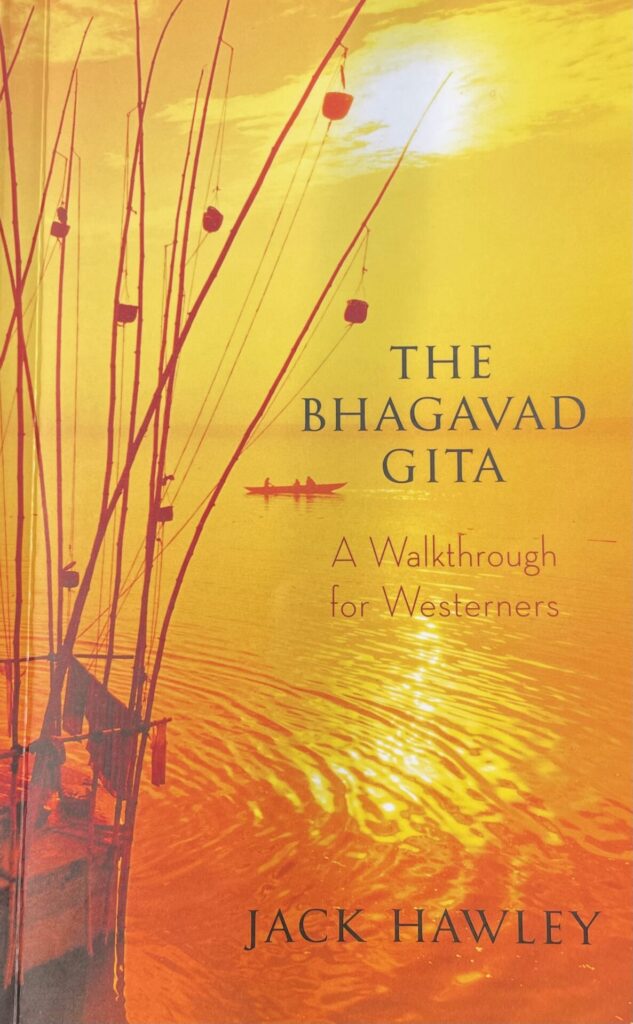The Bhagavad Gita – Summer Book Club is Here!

“There is endless wisdom and inspiration in these pages. The Gita has proven itself over hundreds of generations to be one of the greatest gifts ever given to humanity…Read straight through, as a magnificent story filled with great teaching. Or simply open it to any page at random, and ponder the words, applying them to your life experience.”
Marc Allen New World Library Publisher’s Preface : “Bhagavad Gita – A Walkthrough for Westerners” by Jack Hawley
I am always excited for the summer book club to arrive. It is a great way to share our practice of yoga in a new way through new eyes and writings. This year we are turning to a classical text of yoga, The Bhagavad Gita. For students of yoga, there are three main texts to study and dive deeper into the philosophy and lore of the subject – The Yoga Sutras of Patanjali, The Hatha Yoga Pradipika, and The Bhagavad Gita. Each of these texts hold a different purpose and teaching aspect to the practice of yoga, but for me The Bhagavad Gita is one that has the more “readable story” to it, making it a little more conducive for the Summer Book Club.
The literal translation of The Bhagavad Gita is “The Song of God”. It is written as a poem and is only a small part of a larger Indian Epic, the Mahabharata. The basis of the story is a conversation between two entities. Arjuna, a warrior by caste, is facing his duty (dharma) to take part in a war that he doesn’t want to take part in. He stands before Krisna, the god-figure of the story and one of the major Hindu avatars, asking questions about life and duty and morality and action. Along the way, Krisna teaches Arjuna about the different paths of yoga along with the importance of overcoming our life’s obstacles in order to fulfill our ultimate Divine duty.
So, “what does any of that have to do with me and my yoga?” you might ask. Well, the story of Arjuna and Krisna can be read as a metaphor to the relationship of our own wandering and questioning mind (Arjuna) and that of the higher power or pure consciousness we might possess or relate to (Krisna). The conversation they have in The Bhagavad Gita could easily be one that we have with ourselves numerous times in life – why am I here?, what am I supposed to be doing?, why me?, why now?. The conversation is meant to align our clear and focused divine consciousness with our ever-fluctuating ego self that continues to waiver and change due to life’s work and challenges. No matter what our place, time, or duty in life, this conversation between Krisna and Arjuna shows clearly the way of Yoga, and that is something we can all apply to our practice.
Below will be our reading schedule. We will specifically be following along in the translation by Jack Hawley, subtitled “A Walkthrough for Westerners”.
If you already have another copy or translation at hand, every Bhagavad Gita covers 18 Chapters and will be able to be followed to some extent throughout the summer. The differences show up in translation, commentary, context, and background given by the author. I hope you enjoy this text as much as I do! Or, at least feel challenged and intrigued enough for contemplation and discussion at the end of the summer.
As always, I will follow every week’s reading with a blog. I welcome any and all questions or inquiries along the way to support this writing, and we will hold our one discussion at the end of Aug…stay tuned for the exact date.
- June 3 : Preface and Introduction to Jack Hawley’s “The Bhagavad Gita – a Walkthrough for Westerners”
- June 10 : Chapters 1 and 2
- June 17 : Chapters 3 and 4
- June 24 : Chapters 5 and 6
- July 1 : Chapters 7 and 8
- July 8 : Chapters 9 and 10
- July 15 : Chapters 11 and 12
- July 22 : Chapter 13 ONLY
- July 29 : Chapters 14 and 15
- August 5 : Chapter 16 ONLY
- August 12 : Chapter 17 ONLY
- August 19 : Chapter 18 plus epilogue and afterword